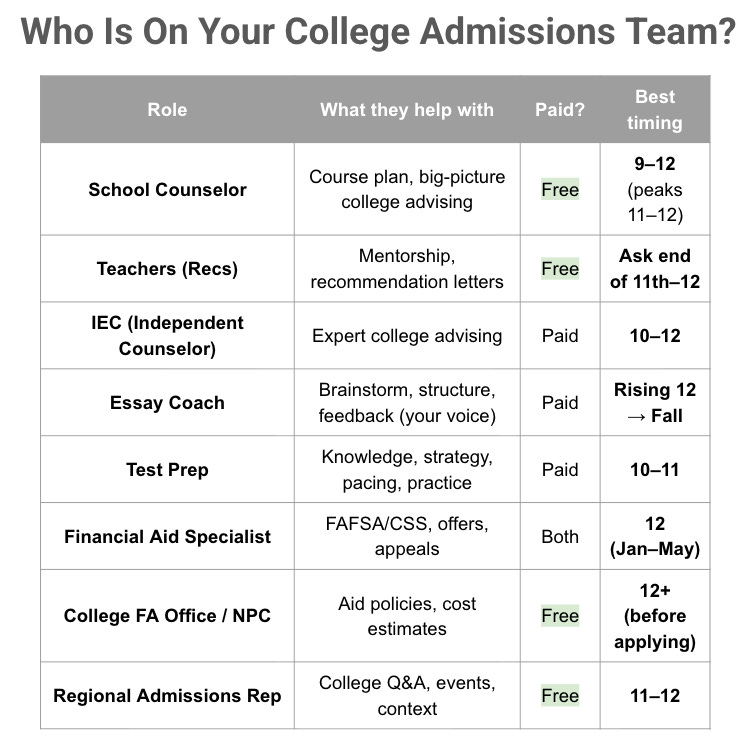Who’s On Your College Admissions Team?
Meet the cast that helps you navigate college admissions. Who helps, what’s free vs paid, and when to use each from 9th grade to decision day.
It is probably possible to navigate the transition from high school to college without help. But, why would you?
There is a large “cast of characters” who specialise in different aspects of the college admissions process that can and will help you. And many of these resources are free (like this Substack).
Know who does what - school-based, community/nonprofit, college-side, outside pros, peer/family.
Engage help at the right time. This is (usually) 9th–12th grade, though can be post-enrollment for aid and success services.
Start with free resources, then add targeted paid help only where it moves the needle.
Verify credentials and ethics before hiring anyone.
The cast (who helps, when, and how)
1/ In-school team (usually free)
School Counselor / College & Career Counselor. Course planning, graduation requirements, post-secondary advising, recommendation letters. Students generally have access in 9–12 grades; but the heaviest engagement tends to be in 11–12. Support is provided both 1:1 + group. 
Teachers (Recommenders).Instruction, mentorship, authentic rec letters. 11–12; 1:1.
504/IEP Case Manager; School Psychologist. Accommodations and documentation pathway. Engage early; 1:1 + team.
Testing/AP/IB Coordinator; Librarian/Media Specialist. Testing logistics and research help. 10–12 (testing); all years for research.
High School Coach / Athletic Director (recruited athletes). Fit assessment, film, outreach aligned to NCAA recruiting calendars, connections with certain colleges. 10–12; 1:1.
Music Director / Choir Director / Theatre Director / Art Teacher (fine arts pathways). Portfolio/audition guidance (repertoire, prescreens, adjudications), advice on BA vs BFA/BM pathways, summer intensives, recommendation letters, competition calendars. 9–12; 1:1 + ensemble/studio.
2/ Outside professionals (paid or mixed; use selectively)
Independent Educational Consultant (IEC). Expert admissions guidance, project-manage apps, lists, timelines, essays, financial/aid, recruiting, and more; coaching; should not ghostwrite. SAT/ACT prep is usually a separate thing. 10–12; 1:1. Verify ethics and capabilities via IECA/HECA membership. 
Essay Coach / Writing Tutor. Brainstorm, structure, feedback (your voice, not theirs). Rising 12–12; 1:1 (or sometimes group workshops).
Test Prep (class/tutor/platform). For both SAT/ACT and sometimes subject-specific tests like AP/IB. Strategy, pacing, practice. 10–12; 1:1 or group.
Financial Aid Specialist. FAFSA/CSS, award comparison, appeals. 12; 1:1. Though, consider leveraging official tools first (see below). 
Scholarship Strategist. Local search focus, calendar, essay reuse plan. 11–12; 1:1 or group (avoid “guarantees”).
Arts Portfolio / Audition Coach. Curation, prescreens, repertoire. 11–12; 1:1.
Athletic Recruiting Advisor. Contact strategy, camps, rules literacy. 10–12; 1:1. Align to NCAA rules.
Executive-Function/ADHD Coach; Mental Health Counselor. Planning systems; stress/anxiety management. Any year; 1:1.
Neuropsych Evaluator (LD/ADHD). Formal testing for testing/college accommodations. As needed; 1:1.
Interview / Communication Coach. Mock interviews, clarity, confidence. 12; 1:1.
Gap-Year Advisor; Career Counselor/Aptitude. Structured alternatives; major/career clarity. 11–post-grad; 1:1.
3/ Free community & nonprofit supports
Federal TRIO (e.g., Upward Bound, Talent Search). Long-term advising/tutoring for eligible students; college & aid navigation. Free; cohort + 1:1. Ask if your school hosts TRIO. 
GEAR UP. Cohort-based college readiness beginning by 7th grade; free; school/district/state partners.
College Advising Corps (near-peer advisers in high schools). Full-time, whole-school advising in partner schools; free to students. 
Libraries, youth orgs, faith/community groups, state agencies. FAFSA nights, scholarship lists, workshops. Free or low cost.
4/ College-side helpers (pre- and post-admission)
Admissions Representative. Your Q&A contact at a college; events; sometimes nuanced context (you can send them direct email, ask questions specific to your circumstances). Free; 10–12.
Financial Aid Office. Policies, special circumstances, verification, professional judgment/appeals. Use the college’s Net Price Calculator (NPC) and the Federal Student Aid Estimator first. NPCs are required at Title IV schools, which is just about every college you’re like to consider; the FSA Estimator gives an early federal-aid estimate. 
After you enroll. Orientation, academic advising, first-year success centers, writing/math centers, disability/access services, study abroad, career services, alumni mentors (tuition-funded).
5/ Peer & family & community network
Parents/Guardians. Logistics, deadlines, forms, encouragement.
Older Students/Alums. Fresh insights on majors, campus life, classes.
Clubs/Student Leaders. Activity ideas; competition calendars.
Online Communities (TikTok, Instagram, Facebook, etc…). Verify tips against official sources; pay close attention to dates of posts as advice that could have been accurate may no longer be.
Takeaways (do these next)
Decide where you could use extra help and support. It is most likely not in all areas listed above.
List your free team (names + emails): school counselor, key teachers, and your top colleges’ admissions + aid contacts. 
If adding paid help, verify ethics (IECA or HECA), insist on clear scope/timeline, and keep the student’s voice in all writing. 
Athletes: map outreach to NCAA recruiting calendars (you can Google these) before you spend on showcases/camps, which generally don’t help. 
Arts, Music, Theatre, Architecture, Design, etc…: make sure to factor in portfolio creation and proof-points of your abilities well ahead of college admissions deadlines.


